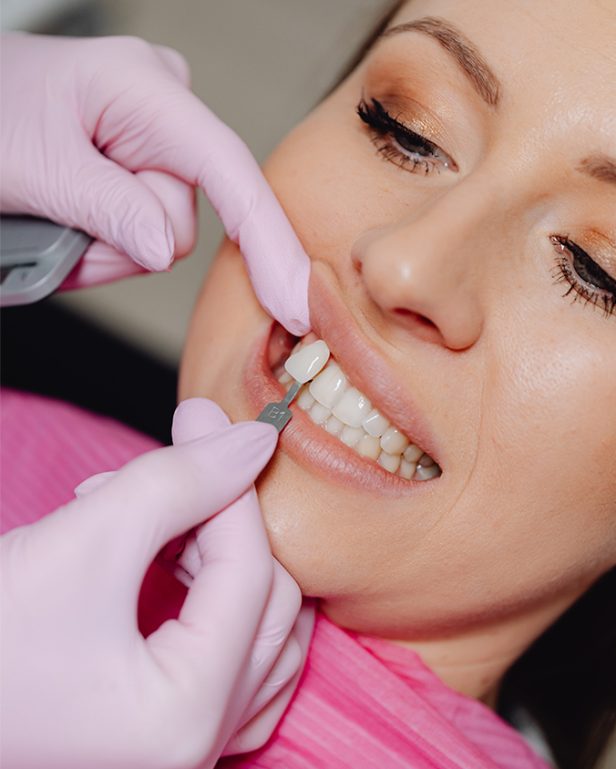Cosmetic Dentist In Kothrud, Pune
If you’re not satisfied with your smile, modern cosmetic dentistry can help. This method of professional oral care focuses on improving the appearance of your mouth, teeth, gums, and overall smile. Common procedures include teeth whitening, veneers, fillings, and implants.
A cosmetic dentist is responsible for a variety of procedures — from minor fixes to major surgeries. Here are a few of the cosmetic procedures they offer.

Teeth Whitening
Teeth whitening is one of the most basic cosmetic dentistry procedures—as well as one of the least expensive. Over time, teeth can become stained from food, drinks, medications, or other habits like smoking. Many people turn to teeth whitening to make their smile brighter. After teeth have been cleaned of plaque, tartar, and other debris, teeth whitening can bleach the surface of teeth to create a brighter, whiter appearance. While over-the-counter products like toothpaste, rinses, and whitestrips can offer some results, professional tooth whitening can provide a shade up to 5 to 8 times lighter.
Dental Veneers
Dental veneers are thin, white shells made from medical-grade porcelain, resin, or ceramic. They’re custom made for each patient to resemble their natural teeth. Before attaching the veneers, the dentist removes some enamel from the tooth’s surface to allow the shells to be bonded realistically to the front of the teeth. Dental veneers can fix a number of cosmetic issues, including crooked teeth, damaged enamel, and gaps between teeth.
Dental Crowns
A dental crown, also known as a dental cap, fits over a decayed or damaged tooth. These crowns can keep a weakened tooth from breaking or used cosmetically to cover misshapen or severely discolored teeth. They can also be used to cover other procedures, like root canals, enamel fillings, dental bridges, or dental implants.
Inlays and Onlays
Inlays and onlays, also known as indirect fillings, are used when a tooth is too decayed to support a typical filling. These fillings are created in a dental laboratory and bonded in place by a cosmetic dentist. An “inlay” is when the material is bonded in the center of the tooth. An “onlay” is when the filling covers one or more parts of the tooth or covers the tooth’s entire surface. This procedure is an alternative to the crown, preserving more of the tooth’s natural surface while still strengthening and restoring the tooth after decay or deterioration.
Dental Implants
After severe tooth decay or tooth loss, dental implants are used to replace teeth. The cosmetic dentist first attaches a screw to the jaw to provide support. Then, the implant is inserted into the bone socket of the missing tooth. Over time, the bone and tissue fuse to the implant, securing the replacement tooth inside the mouth. Once properly attached, the dental implant should blend into the surrounding teeth
Dental Bonding
For dental bonding, the cosmetic dentist applies a moldable resin to the tooth and hardens it with ultraviolet light. Then, they trim, shape, and polish the material to blend into the surface of the tooth. Bonding can repair chips, cracks, misshapen teeth, and tooth decay. For minor cosmetic issues, bonding is a more affordable alternative to fillings or crowns.
Education and Training
While cosmetic dentistry is a widely practiced industry, it’s not currently recognized as a specialty by the American Dental Association. Therefore, universities typically don’t offer degree programs in that area. However, most cosmetic dentists first receive training through other dental school programs. Dental students train for four years and typically require a bachelor’s degree to enroll. Program training includes:
- Orthodontics (the dental practice of aligning teeth with braces or other means)
- Pain management
- Dental history and law
- Cosmetic dentistry
- Oral medicine
Upon completion of a program, prospective cosmetic dentists must seek a medical license. They may also receive accreditation.
Reasons to See a Cosmetic Dentist
There are many reasons you might see a cosmetic dentist, including:
- Tooth decay
- Damage (cracks, chips, etc.)
- Crooked teeth
- Misshapen teeth
- Discoloration
- Missing teeth
People with damaged, decaying, crooked, or discolored teeth may also have difficulty when eating and speaking. For others, dental issues may affect their self-esteem.
According to a 2015 survey by the American Dental Association, 33% of young people are reluctant to smile due to conditions of the teeth and mouth. Another 23% of adults have cut back on their participation in social activities due to embarrassment about their smiles. If you feel dissatisfied with your smile, a cosmetic dentist can improve the condition of your teeth.

